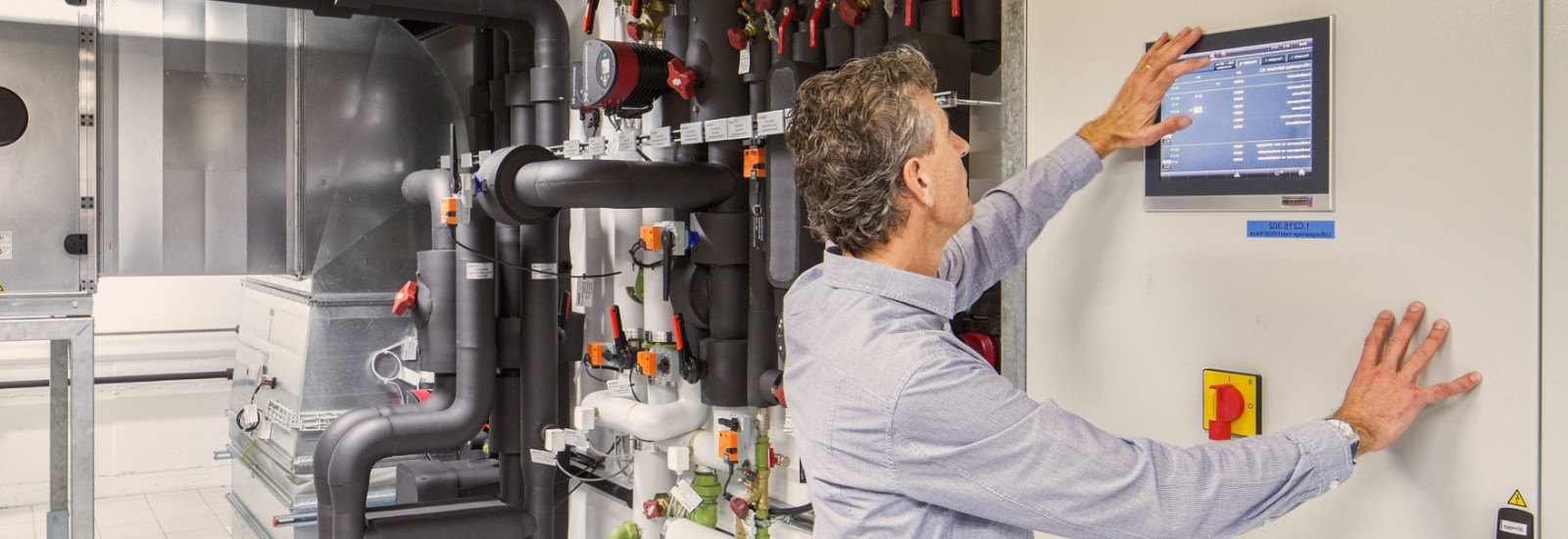Around the world, VAT valves are usually found in climate-controlled, clean room environments where the world’s most advanced semiconductors and flat panel displays are fabricated, or in massive research facilities that systematically probe the limits of human knowledge. These cutting-edge venues provide a stark contrast to the VAT manufacturing facilities where the vacuum valves and bellows first take shape.
The massive metal-tooling and hydraulic systems that shape metal blocks into extremely precise and durable mission critical components generate heat while they work… a lot of heat. 15 GW of energy are consumed annually by the three VAT production facilities in Haag, Switzerland, and 80% of that energy results in waste heat.
“Because of the enormous amount of heat produced in our manufacturing plants, we need to cool the machinery all year round, even during cold winter months,” explains Andreas Fickl, Head of VAT Facility Management.
Drafty air and cleanliness requirements
Previously, waste heat generated at the manufacturing plants in Haag was simply released into the production areas. This added heat made the work areas extremely hot during the warmer months of the year. An initial solution simply added A/C units to each production hall. However, this system was unable to maintain the needed work area temperatures of 20-26 °C. In addition, the 16°C cold air blown in caused drafts in some areas, which made employees uncomfortable. The air circulation further resulted in favoring evaporation of oil aerosols from the production machines into the hall air.
“We quickly realized that we needed a more efficient solution to optimize the production areas,” says Andreas Fickl. “It was also a very inefficient way to cool the machines indirectly via the hall air. Add to that the lack of a redundant cooling system and you could have production downtimes during cooling system overloads.”
Going Green with Groundwater
As part of a global effort to reduce the company’s ‘carbon footprint,’ the VAT Facility Management team began development of an energy-saving cooling concept for all three facilities. Working with a heating/cooling consultancy, the VAT team optimized and launched a sustainable cooling process based on the use of local groundwater.
In the new system, groundwater is drawn from a well in close proximity to the VAT site, circulated through a closed system of pipes to a heat exchanger and returned into the ground. The cold-water system circulating through the heat exchanger is cooled by the groundwater and then pumped to the production machinery (and to the VAT offices). The cold-water system circulating through a closed pipe circuit keeps the machinery at a constant temperature. Unlike the previous refrigerant systems (with chlorinated hydrocarbons), the new system provides a much more efficient and sustainable cooling method.
Today, a walk through the production facilities highlights a number of benefits of the groundwater cooling system:
- Overall energy cost reduction of 75% (even when accounting for the municipal water costs)
- High-tech heat exchanger enables more energy per m³ of water
- More stable ambient workplace temperature
- Cleaner working conditions, as fewer oil aerosols are released into the hall air
- Built-in redundant cooling system ensures less production downtime
- New cooling system hardware requires 3-4x less space – and is much quieter
- Easy switch between warmth in the winter and cooling in the summer for workplaces and offices
“The beauty of the system is sustainability,” adds Andreas Fickl. “The water is drawn out of the ground at 11-12° and returns to the ground after passing through the heat exchanger. There is absolutely no contamination or evaporation loss – and no environmental effect, as the heat load dissipates quickly deep underground.”
Taking the concept around the world
Two VAT production facilities in Haag were upgraded to the new groundwater system in 2011. The third facility was converted in 2019, completing the transformation for all production sites in Haag. With a total of 30 cooling systems for all three sites, the amortization of the new infrastructure will be achieved after only three years of operation, adding to future energy savings.
“The success of the groundwater cooling concept in Switzerland has led to plans to extend an identical solution to our other sites in Romania and Malaysia,” adds Andreas Fickl. “Our efforts to better conserve and protect resources, minimize emissions, and improve energy efficiency – all this underlines the VAT goal of creating a completely sustainable company.”
